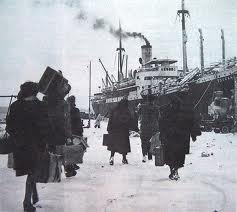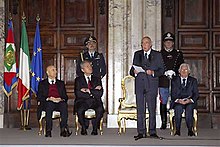National Memorial Day of the Exiles and Foibe
| National Memorial Day of the Exiles and Foibe | |
|---|---|
 | |
| Official name | Italian: Giorno del ricordo |
| Observed by | |
| Liturgical color | green, white and red |
| Significance | Commemoration of the victims of the Foibe and the Istrian–Dalmatian exodus |
| Date | 10 February |
| Next time | 10 February 2025 |
| Frequency | annual |
| First time | 10 February 2005 |
| Related to |
|
National Memorial Day of the Exiles and Foibe (Italian: Giorno del ricordo, English: Day of Remembrance) is an Italian commemoration of the victims of the Foibe and the Istrian–Dalmatian exodus, which led to the emigration of hundreds of thousands (between 230,000 to 350,000) of local ethnic Italians (Istrian Italians and Dalmatian Italians) from Yugoslavia after the end of the Second World War.[1][2]
The Italian Law 92 of 30 March 2004 instituted a Day of Remembrance on 10 February to commemorate the victims of Foibe and the forced exodus of nearly the entire population of Italian origin living in Dalmatia and Julian March brought about by Yugoslavia.[3] The law also instituted a special medal to be conferred on relatives of victims.[3]
The date of 10 February is the day on which the peace treaties of Paris were signed. These treaties transferred the previously Italian areas of Istria, Kvarner, the Dalmatian city of Zadar and most of Julian March to Yugoslavia.[4]
Law's motivation
[edit]
National Memorial Day is held annually on 10 February and is observed by all Italian political parties including the President and municipal mayors.[5] It commemorates the foibe massacres and Istrian–Dalmatian exodus.[6] According to recent studies and a work by the historian Guido Rumici the total number of Italian victims (including people murdered during their imprisonment or deportation) ranges between 6,000 and 11,000 killed, and between 230,000 to 350,000 expelled or fled from Dalmatia, Istria and the area bordering Slovenia.[1][2]
Introduction of the Law
[edit]Exiles requested recognition of the Foibe for a long time but diplomatic reasons delayed progress, given Italy's peaceful relations with Yugoslavia after the Tito–Stalin split and during the rest of the Cold War. After the fall of Soviet Union and the dissolution of the Italian Communist Party in January 1991, a bill was passed.[7] Italian deputies and senators almost unanimously voted in favour, and the law passed as number 92 on 30 March 2004.[8]
Law's effect
[edit]

The National Memorial Day of the Exiles and Foibe is a civilian memorial day but not a non-working holiday.[9] The law grants an award, but no money, to all relatives of murder victims, upon request.[3] Those who died in Nazi concentration camps are also considered victims. The award consists of a certificate and a metal insignia with the wording The Italian Republic remembers.[3] The law also institutes two museums; the Museum of Istrian-Dalmatian civilization in Trieste and the historical archive museum of Fiume, transported to Rome.[3]
Approval and criticism
[edit]Italian president Giorgio Napolitano gave an official speech during the 2007 celebration of the "Memorial Day of Foibe Massacres and Istrian-Dalmatian exodus" in which he stated:[10]
...Already in the unleashing of the first wave of blind and extreme violence in those lands, in the autumn of 1943, summary justice and tumult, nationalist paroxysm, and social retaliation were intertwined with a plan to eradicate the Italian presence from what had been, but ceased to be, the Julian Marches (Venezia Giulia). There was therefore a movement of hate and bloodthirsty fury, and a Slavic annexationist plan, which prevailed above all in the peace treaty of 1947, and which assumed the sinister shape of an "ethnic cleansing". What we can say for sure is that what occurred - in the most evident way through the inhuman ferocity of the foibe - was one of the barbarities of the past century.
— Italian president Giorgio Napolitano, Rome, 10 February 2007[11]
See also
[edit]- Istria
- History of Dalmatia
- Foibe massacres
- Istrian Italians
- Dalmatian Italians
- Istrian-Dalmatian exodus
- Ethnic cleansing
- Anti-Italianism
- Croatization
- Public holidays in Italy
- Anniversary of the Unification of Italy
- Anniversary of the Liberation
- Festa della Repubblica
- National Unity and Armed Forces Day
- Tricolour Day
References
[edit]- ^ a b Thammy Evans & Rudolf Abraham (2013). Istria. Bradt Travel Guides. p. 11. ISBN 9781841624457.
- ^ a b James M. Markham (6 June 1987). "ELECTION OPENS OLD WOUNDS IN TRIESTE". The New York Times. Retrieved 9 June 2016.
- ^ a b c d e Legge n. 92 del 30 marzo 2004
- ^ "Prima assoluta on-line per il Giorno del ricordo" (in Italian). 10 February 2021. Retrieved 13 April 2021.
- ^ ""Giorno del ricordo" - Il Sindaco ricorda le vittime delle foibe" (in Italian). Retrieved 13 April 2021.
- ^ "Le Foibe degli altri: migliaia di anticomunisti sloveni e croati uccisi da Tito" (in Italian). 20 January 2012. Retrieved 13 April 2021.
- ^ Article by Daniel J. Wakin
- ^ "Declaration of Vote". Transcript of the 561st Session of the Italian Senate (in Italian). pp. 38 and following. Archived from the original (PDF) on 10 October 2007. Retrieved 5 May 2011.
- ^ Official Italian law
- ^ Presidenza della Repubblica, Giorgio Napolitano, official speech for the celebration of "Giorno del Ricordo" Quirinal, 10 February 2007 integral text from official website of the Italian President Bureau
- ^ «....Già nello scatenarsi della prima ondata di cieca violenza in quelle terre, nell'autunno del 1943, si intrecciarono giustizialismo sommario e tumultuoso, parossismo nazionalista, rivalse sociali e un disegno di sradicamento della presenza italiana da quella che era, e cessò di essere, la Venezia Giulia. Vi fu dunque un moto di odio e di furia sanguinaria, e un disegno annessionistico slavo, che prevalse innanzitutto nel Trattato di pace del 1947, e che assunse i sinistri contorni di una "pulizia etnica". Quel che si può dire di certo è che si consumò - nel modo più evidente con la disumana ferocia delle foibe - una delle barbarie del secolo scorso.» from the official website of The Presidency of the Italian Republic, Giorgio Napolitano, official speech for the celebration of "Giorno del Ricordo" Quirinal, Rome, 10 February 2007
External links
[edit]- (in Italian) Text of the law on the National Memorial Day of the Exiles and Foibe
- (in Italian) Giorno del ricordo
